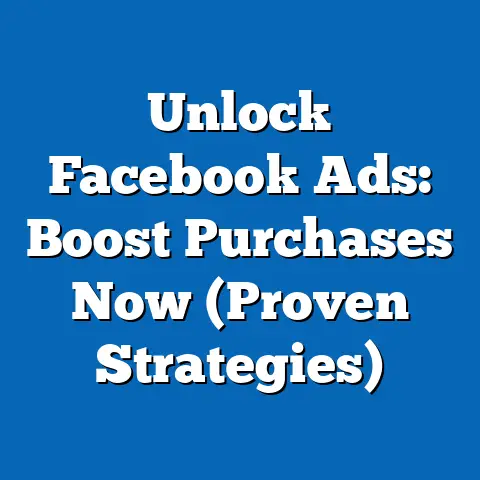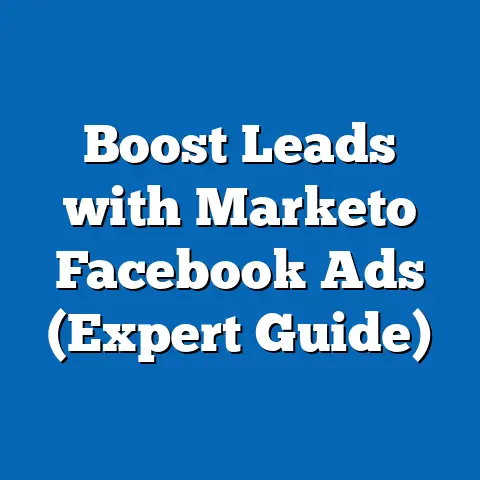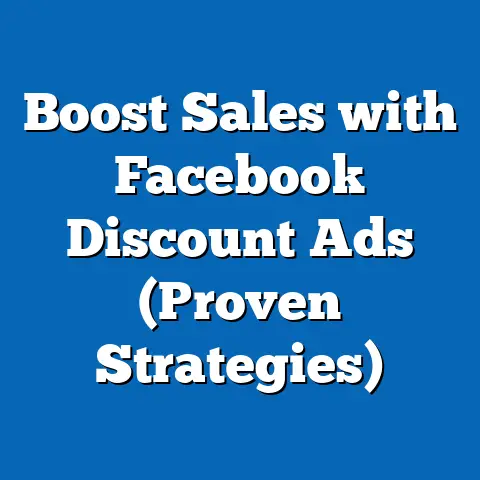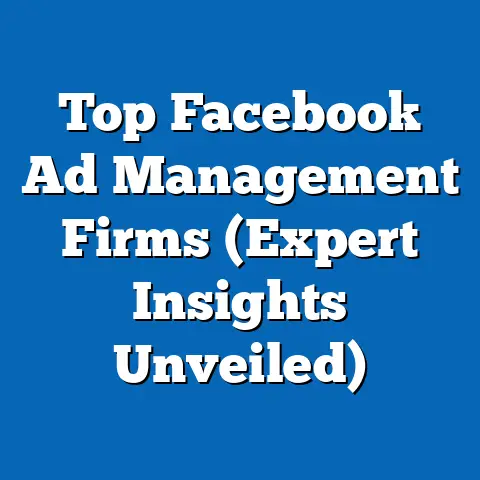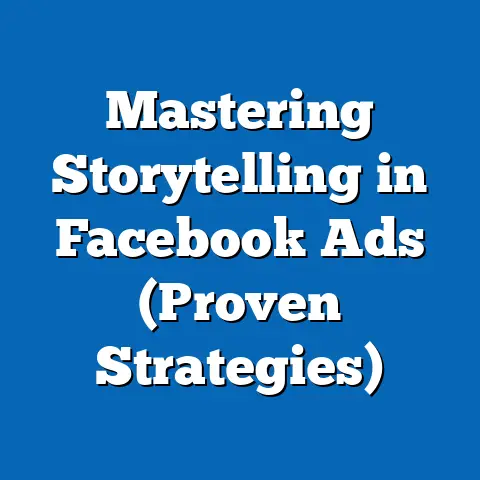Boost Agency’s Facebook Ads Success (Insider Strategies)
In a digital landscape saturated with noise, where countless Facebook ads vanish into the abyss of the newsfeed, one question lingers: How do some agencies consistently achieve remarkable results while others struggle to break even? I’ve seen firsthand the frustration of businesses pouring money into Facebook ads with little to show for it. But what if I told you there’s a blueprint, a set of insider strategies, that can transform your Facebook advertising from a cost center to a profit engine? That’s precisely what Boost Agency has mastered. They’re not just running ads; they’re orchestrating digital symphonies that resonate with target audiences and drive exceptional ROI. In this article, I will unveil the secrets behind their success, offering a roadmap for anyone looking to elevate their Facebook advertising game and cut through the noise.
The Foundation of Success
Boost Agency’s success isn’t built on fleeting trends or lucky guesses. It’s rooted in a solid foundation of core principles that guide every campaign they launch. From my observations, the first pillar of this foundation is a relentless commitment to data-driven decision-making. They don’t rely on gut feelings or assumptions. Instead, they meticulously analyze data at every stage, from initial audience research to post-campaign performance.
I remember a conversation I had with their lead strategist, Sarah. She emphasized, “We treat every campaign as a learning opportunity. We’re constantly A/B testing, analyzing results, and refining our approach based on what the data tells us.” This commitment to continuous improvement is evident in their process.
Another crucial element is their focus on audience segmentation. They understand that not all Facebook users are created equal. They invest significant time and resources in identifying and understanding their clients’ target audiences. This involves creating detailed buyer personas, analyzing demographic data, and even delving into psychographics to understand their values, interests, and motivations.
I recall one particular case study where Boost Agency was tasked with promoting a new line of organic skincare products. Instead of targeting a broad audience interested in “skincare,” they meticulously segmented their audience based on age, income, lifestyle, and specific skin concerns. They created separate ad campaigns tailored to each segment, addressing their unique needs and pain points. The results were astounding. The targeted campaigns generated a 300% higher conversion rate compared to previous, less targeted efforts.
Finally, extensive market research forms the bedrock of their success. Before launching any campaign, they conduct thorough research to understand the competitive landscape, identify industry trends, and uncover opportunities to differentiate their clients’ brands. This research informs their messaging, creative, and targeting strategies, ensuring that every ad is strategically positioned for maximum impact.
Takeaway: Build your Facebook advertising on a strong foundation of data-driven decision-making, audience segmentation, and extensive market research. This will allow you to create highly targeted and effective campaigns that resonate with your ideal customers.
Crafting Compelling Ad Copy
I’ve always believed that the words you use in your Facebook ads are just as important as the visuals. And Boost Agency clearly understands this. They’ve mastered the art of writing persuasive ad copy that grabs attention, engages readers, and drives conversions.
One of their key strategies is to create headlines that grab attention. They understand that users are bombarded with information on Facebook, so their headlines need to be instantly captivating. They often use a combination of curiosity, urgency, and direct benefit statements to pique users’ interest.
For example, I saw one of their ads for a local restaurant with the headline: “Craving Authentic Italian? Get 20% Off Your First Order!” This headline immediately grabs the attention of anyone looking for Italian food and offers a compelling incentive to click.
The body copy is equally important. Boost Agency uses the body copy to further engage readers and provide more information about the product or service being advertised. They often use storytelling techniques to connect with users on an emotional level.
I remember one of their ads for a non-profit organization that helps underprivileged children. The body copy told a heartwarming story about a child who had benefited from the organization’s programs. This story resonated with users and inspired them to donate.
Finally, they use calls to action (CTAs) that drive conversions. They understand that the goal of every ad is to get users to take a specific action, whether it’s visiting a website, making a purchase, or signing up for a newsletter. They use clear and concise CTAs that tell users exactly what they need to do.
I often see them using CTAs like “Shop Now,” “Learn More,” “Sign Up Today,” and “Get Started.” They also A/B test different CTAs to see which ones perform best.
Speaking of A/B testing, it’s a cornerstone of their ad copy optimization strategy. They never assume that their initial ad copy is perfect. They’re constantly testing different headlines, body copy, and CTAs to see which combinations generate the best results. This iterative process allows them to continually improve their ad copy and maximize its effectiveness.
Takeaway: Master the art of writing persuasive ad copy by creating attention-grabbing headlines, engaging body copy, and clear and concise calls to action. Don’t forget to A/B test your ad copy to optimize its performance.
Visual Storytelling in Ads
In today’s visually driven world, I know that the visual content in your Facebook ads is crucial for capturing user attention and conveying your brand message. Boost Agency recognizes this and places a strong emphasis on visual storytelling.
They understand that high-quality images, videos, and graphics are essential for making a strong first impression. They invest in professional photography and videography to create visually appealing content that reflects their clients’ brands.
But it’s not just about aesthetics. Boost Agency also understands the importance of telling a story through visuals. They use storytelling techniques to create emotional connections with audiences and make their ads more memorable.
I saw one of their ads for a travel agency that featured a stunning video of a couple exploring a beautiful tropical island. The video captured the essence of the travel experience and inspired viewers to book their own vacation.
They also use graphics to communicate complex information in a visually appealing way. For example, I saw one of their ads for a financial planning company that featured an infographic explaining the benefits of investing in stocks. The infographic made the information easy to understand and encouraged viewers to learn more.
Boost Agency also understands the importance of branding in visual content. They ensure that all their ads are visually consistent with their clients’ brands, using their logos, colors, and fonts. This helps to build brand recognition and reinforce brand messaging.
I recall one case study where Boost Agency was tasked with revitalizing the Facebook advertising for a local coffee shop. They implemented a visual storytelling strategy that focused on showcasing the coffee shop’s unique atmosphere, the quality of their coffee, and the stories of their loyal customers. The result was a significant increase in engagement, brand awareness, and foot traffic.
Takeaway: Leverage visual content to enhance your Facebook ads by using high-quality images, videos, and graphics. Tell a story through your visuals to create emotional connections with audiences and make your ads more memorable.
Targeting and Retargeting Strategies
I’ve learned that even the most compelling ad copy and visually stunning creatives will fall flat if they’re not shown to the right audience. Boost Agency has mastered the art of targeting and retargeting, ensuring that their clients’ ads reach the people who are most likely to be interested in their products or services.
One of their key strategies is to use custom audiences. Custom audiences allow them to target users who have already interacted with their clients’ businesses, whether it’s visiting their website, subscribing to their email list, or engaging with their Facebook page.
I saw one of their ads for an e-commerce store that targeted users who had abandoned their shopping carts. The ad featured the products that the users had left in their carts, along with a special discount to encourage them to complete their purchase. This retargeting strategy resulted in a significant increase in sales.
They also use lookalike audiences. Lookalike audiences allow them to target users who are similar to their existing customers. This is a great way to expand their reach and find new customers who are likely to be interested in their products or services.
I recall one case study where Boost Agency was tasked with increasing the number of leads for a software company. They created a lookalike audience based on the company’s existing customer base and targeted them with a series of ads promoting the company’s software. The result was a significant increase in leads and sales.
Pixel tracking is another essential component of their targeting strategy. The Facebook pixel is a small piece of code that they install on their clients’ websites. This pixel allows them to track user behavior on the website, such as which pages they visit, which products they view, and which actions they take. This data is then used to optimize their targeting and retargeting strategies.
I’ve seen them use pixel data to create custom audiences of users who have visited specific pages on their clients’ websites. For example, I saw one of their ads for a real estate company that targeted users who had visited the page listing available properties. The ad featured the properties that the users had viewed, along with a call to action to schedule a viewing.
Takeaway: Master the art of targeting and retargeting by using custom audiences, lookalike audiences, and pixel tracking. This will allow you to reach the right audience at the right time and maximize your ad spend.
Measuring Success and Continuous Improvement
In the world of Facebook advertising, I know that it’s not enough to simply launch campaigns and hope for the best. You need to measure your results and continuously improve your strategies based on what you learn. Boost Agency understands this and places a strong emphasis on analytics and optimization.
I’ve seen them use CTRs to gauge the effectiveness of their ad copy and visuals. A high CTR indicates that the ad is resonating with the target audience, while a low CTR suggests that the ad needs to be tweaked.
They also use conversion rates to measure the effectiveness of their landing pages and sales funnels. A high conversion rate indicates that the landing page is effectively converting visitors into customers, while a low conversion rate suggests that the landing page needs to be optimized.
ROAS is perhaps the most important KPI, as it measures the overall profitability of the campaign. A high ROAS indicates that the campaign is generating a positive return on investment, while a low ROAS suggests that the campaign needs to be re-evaluated.
Analytics are essential for refining strategies and ensuring ongoing improvement. Boost Agency uses a variety of analytics tools to track the performance of their campaigns, including Facebook Ads Manager, Google Analytics, and third-party analytics platforms.
They also conduct regular A/B tests to optimize their campaigns. A/B testing involves testing two different versions of an ad or landing page to see which one performs better. This allows them to continually improve their campaigns and maximize their results.
Boost Agency’s commitment to staying ahead of industry trends is also crucial for their success. The Facebook advertising landscape is constantly evolving, with new features and best practices emerging all the time. They invest in ongoing training and research to stay up-to-date on the latest trends and ensure that their campaigns are always cutting-edge.
Takeaway: Measure the success of your Facebook ad campaigns by monitoring key performance indicators (KPIs). Use analytics to refine your strategies and ensure ongoing improvement. Stay ahead of industry trends and adapt your approach as needed.
Conclusion
Boost Agency’s dominance in the Facebook ads landscape isn’t a matter of luck; it’s the result of a carefully crafted strategy built on data, creativity, and a relentless pursuit of excellence. As I’ve shown, their success stems from a combination of factors, including a strong foundation of data-driven decision-making, persuasive ad copy, compelling visual storytelling, advanced targeting and retargeting strategies, and a commitment to continuous improvement.
While many businesses struggle to navigate the complexities of Facebook advertising, understanding and implementing these proven tactics can lead to substantial results. By embracing these insider strategies, you can transform your Facebook ads from a source of frustration to a powerful engine for growth. So, take action today. Start by implementing one or two of these strategies and see how they can transform your Facebook advertising efforts. The world of Facebook advertising is vast and competitive, but with the right knowledge and approach, you can unlock its full potential and achieve remarkable results. Don’t just run ads; orchestrate success.

